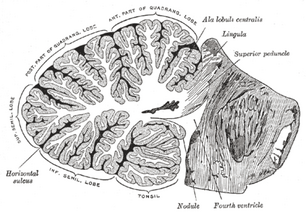The cerebellopontine angle syndrome
From WikiLectures
The cerebrospinal angle is the space between the cerebellum and the pons, which is filled with cerebrospinal fluid and is a very common site of vestibular schwannoma. Expansion in that area accounts for 10% of all intracranial tumors and causes a set of symptoms we call pontocerebellar angle syndrome.
Content of the pontine angle[edit | edit source]
- cranial nerves: n. facialis, n. vestibulocochlearis
- flocculus
- lateral recess of the fourth cerebral ventricle
Symptoms[edit | edit source]
- cerebellar syndrome
- peripheral paresis of VII.
- ipsilateral impairment of the corneal reflex
- balance disorders
- hypacus
- tinnitus
- vertigo
- nystagmus
- diplopia
Causes[edit | edit source]
- schwanoma n. VIII.
- meningioma
- epidermoid
- cerebellar astrocytoma
- glomus jugulare
- metastases
Links[edit | edit source]
Related articles[edit | edit source]
- Tumors of the pontine angle/PGS/diagnosis
- Cerebellum
- Pons Varoli
- Schwannoma
- Cerebellar syndrome
- Facial nerve palsy
- Nervus vestibulocochlearis
- Nervus facialis
- Nystagmus
- Vertigo
- Astrocytoma
- Meningeoma
- Epidermoid
Reference[edit | edit source]
- LARNER, Andrew J.. A-Z of Neurological Practice : A Guide to Clinical Neurology. 2nd edition. 2011. ISBN 978-1-84882-994-7.
- ROSAHL, S.. Cerebellopontine angle and posterior cranial fossa [online]. ©2013. [cit. 2013-02-16]. <https://www.uniklinik-freiburg.de/neurochirurgie.html>.



